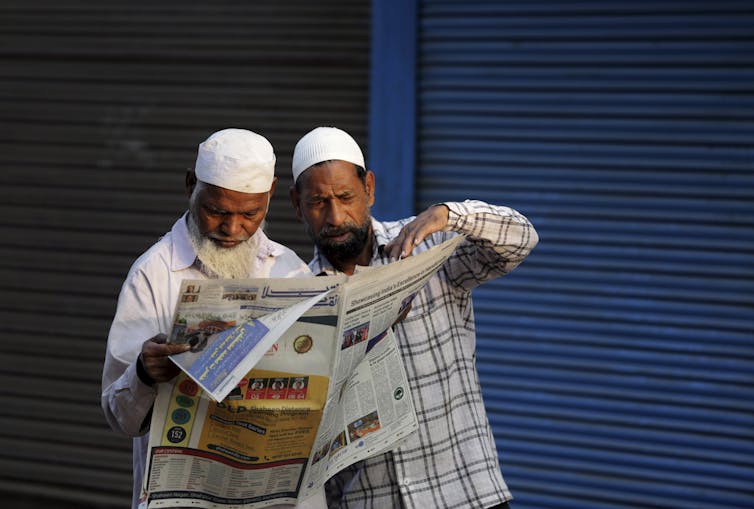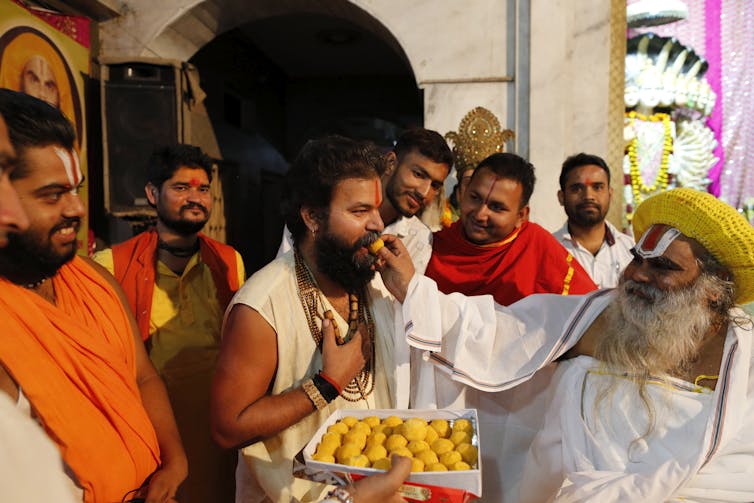Why Hindu nationalists are cheering moves to build a temple, challenging a secular tradition
- Written by Sumit Ganguly, Distinguished Professor of Political Science and the Tagore Chair in Indian Cultures and Civilizations, Indiana University
A five-judge panel of the Indian Supreme Court has delivered its much-awaited verdict on the destruction of the Babri Masjid, a 16th-century mosque in the town of Ayodhya in the north Indian state of Uttar Pradesh.
The court case had been lodged after a mob of Hindu zealots attacked and destroyed the Babri Mosque on Dec. 16, 1992. They believed[1] that the mosque had been constructed on the ruins of a Hindu temple[2] during the reign of Babur, the founder of the Mughal dynasty in India in the 16th century. Hundreds were killed in a spate of riots that followed the demolition of the mosque.
The court ruled[3] on Nov. 8 that the 2.77-acre site of the mosque should be handed over to the government, which could then form a trust to build a Hindu temple on that site. Simultaneously, it granted five acres of land in another part of the town for the construction of a mosque.
The court also conceded that the destruction of the mosque by a mob was unlawful and that the five acres granted for a mosque constituted a form of restitution.
This controversial ruling is considered a win for Prime Minister Modi and his party, which has come to be associated with rise in Hindu nationalism. As a political scientist[4], I believe the question now is whether India will remain committed to secularism, which is enshrined in its Constitution.
A history of the dispute
The dispute itself goes back to a time when India was emerging from British colonial rule. In 1949, Hindu activists surreptitiously entered the mosque and placed religious idols within it, claiming that Lord Rama had returned to reclaim[5] his birthplace. The government, in an attempt to quell discord, had the doors to the mosque locked.
 Indian Muslims in Ayodhya read about the Ayodhya verdict delivered on Nov. 8.
AP Photo/Rajesh Kumar Singh[6]
Indian Muslims in Ayodhya read about the Ayodhya verdict delivered on Nov. 8.
AP Photo/Rajesh Kumar Singh[6]
This ruling has brought these past divides to the fore. While the Sunni Waqf Board, a government-supported body that was the litigant on the side of the mosque, expressed disappointment[7] with the Supreme Court’s ruling, the right-wing ruling Bharatiya Janata Party expressed happiness.
As Lal Krishna Advani, a senior member of the Bharatiya Janata Party who had spearheaded the movement to build the temple in the 1980s, stated[8]:
“This is a moment of fulfillment for me because God Almighty had given me an opportunity to make my own humble contribution to the mass movement, the biggest since India’s Freedom Movement, aimed at the outcome which the Supreme Court’s verdict today has made possible.”
Advani’s statement reflects the broader sentiments of many in the ruling party.
Crucial to ideological identity
Why is the construction of Ram temple so important for the ruling Bharatiya Janata Party?
The answer can be traced to Bharatiya Janata Party’s ideology and political developments in India[9] following independence from British colonial rule in 1947.
The Bharatiya Janata Party is a successor to the Bharatiya Jana Sangh, a political party founded in 1951. It sought from the outset to serve as a right-of-center, Hindu majoritarian alternative[10] to the dominant, secular, nationalist party, the Indian National Congress.
However, for several decades the Bharatiya Jana Sangh failed to make much headway. Its opposition, the Congress Party, was quite popular and remained electorally dominant. In 1980 the Bharatiya Jana Sangh was reincarnated as the Bharatiya Janata Party[11].
The Bharatiya Janata Party, like its predecessor, the Bharatiya Jana Sangh, shared an identical Hindu chauvinist ideological orientation. Not until the late 1980s did it embrace an overtly pro-Hindu ideology focused on the building of a temple at the site of the Babri Masjid. And it began to see electoral success.
Since then, the rise of the Bharatiya Janata Party has been nothing short of extraordinary. In 1984 the party had two seats in the 543-seat Indian Parliament. Today it has a commanding majority of 303. Much of this can be attributed to the successful mobilization and consolidation of the Hindu vote in the 1980s.
Challenge to pluralism
In an attempt to win back the Hindu vote the Indian National Congress Party in 1986 arranged to have the locks to the Babri mosque in Ayodhya removed to enable Hindu worshipers to enter the premises[12] for the first time in 35 years. Hindu miscreants had placed idols in this site in 1949.
Following this decision, the Bharatiya Janata Party started a steady drumbeat of sentiment to construct a Hindu temple at the site in the late 1980s and early 1990s. Specifically, in September and October 1990, senior leader of Bharatiya Janata Party Lal Krishna Advani took out a “rath yatra,” or a chariot consecrating Lord Rama across much of the country. This movement, which gathered steam over the course of a decade, culminated in the destruction of the mosque.
 Sweets are distributed after a verdict in over a disputed structure in Ayodhya, India, on Nov. 9, 2019.
AP Photo/Rajesh Kumar Singh[13]
Sweets are distributed after a verdict in over a disputed structure in Ayodhya, India, on Nov. 9, 2019.
AP Photo/Rajesh Kumar Singh[13]
After the destruction of the mosque, the electoral fortunes of the Bharatiya Janata Party continued to improve. By 1998, it had become the dominant partner in a coalition government composed of a range of political parties[14] to form a government.
When the Bharatiya Janata Party returned to power under Prime Minister Modi in 2014, it focused on other matters while occasionally paying some attention to the question of the mosque even though it had been part of its election manifesto[15]. In effect, the Bharatiya Janata Party kept this issue alive in the public arena but did not undertake an active efforts to change the status quo at the site.
Now, in its second term, the ruling Bharatiya Janata Party has been handed an unexpected victory with the Supreme Court judgment. I believe building a Hindu temple on the site of the destroyed Ayodhya mosque will bolster its following among the most fervid Hindu followers.
[ You’re smart and curious about the world. So are The Conversation’s authors and editors. You can read us daily by subscribing to our newsletter[16]. ]
References
- ^ believed (www.press.uchicago.edu)
- ^ constructed on the ruins of a Hindu temple (books.google.com)
- ^ The court ruled (www.cnn.com)
- ^ political scientist (www.journalofdemocracy.org)
- ^ returned to reclaim (economictimes.indiatimes.com)
- ^ AP Photo/Rajesh Kumar Singh (www.apimages.com)
- ^ expressed disappointment (www.indiatoday.in)
- ^ stated (www.indiatoday.in)
- ^ ideology and political developments in India (books.google.com)
- ^ serve as a right-of-center, Hindu majoritarian alternative (www.cambridge.org)
- ^ reincarnated as the Bharatiya Janata Party (books.google.com)
- ^ enter the premises (www.thehindu.com)
- ^ AP Photo/Rajesh Kumar Singh (www.apimages.com)
- ^ range of political parties (books.google.com)
- ^ been part of its election manifesto (www.journalofdemocracy.org)
- ^ You can read us daily by subscribing to our newsletter (theconversation.com)
Authors: Sumit Ganguly, Distinguished Professor of Political Science and the Tagore Chair in Indian Cultures and Civilizations, Indiana University

